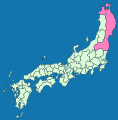Mutsu Province
![]()
Rikuo is a redirect to this article. For the former Japanese vehicle manufacturer, see Rikuo Nainenki.
Mutsu (Jap. 陸奥国, Mutsu no kuni) or Ōshū (奥州) was one of the historical provinces of Japan, encompassing the area of present-day Fukushima, Miyagi, Iwate, and Aomori prefectures, as well as the towns of Kazuno and Kosaka in Akita Prefecture.
Originally, the province was called Michi-no-oku (道奥国, - no kuni, roughly "end of the road") and until the Heian period Michi-no-ku (陸奥国, - no kuni, roughly "end of the mainland").
In the 8th century it was the second most populous province in Japan, with 186,000 inhabitants. The historical capital (kokufu) was Tagajō.
Mutsu in northern Honshū was one of the last provinces formed when the land was taken from the native Ainu. It became one of the largest in Japan as it expanded northward. The ancient capital was located in the modern Miyagi Prefecture. In the Sengoku period, various families ruled individual parts of the province. The Uesugi had a castle at Aizu-Wakamatsu in the south, the Nambu at Morioka in the north, and Date Masamune a close ally of the Tokugawa founded Sendai, now the largest city in the Tohoku region.
On 19 January 1869 (Meiji 1/12/7), 4 other provinces were created from parts of Mutsu: Rikuchū Province (Eng. "Middle Mutsu"), Rikuzen Province (Eng. "Front Mutsu"), and Iwaki Province and Iwashiro Province which were both named after historical predecessors. To distinguish it from the old Mutsu Province, the characters of the new smaller Mutsu were read analogously as Rikuō. Outside of official documents, however, this reading did not prevail.
· 
Mutsu province from the end of the 7th century until 712
· 
Mutsu Province 718 after the separation of Iwase Province in the southwest and Iwaki Province in the southeast.
· 
Mutsu Province until 1868
· .svg.png)
Mutsu/Rikuō Province as of 1869
Search within the encyclopedia